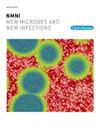Wolbachia: A bacterial weapon against dengue fever- a narrative review of risk factors for dengue fever outbreaks
IF 2.9
Q2 INFECTIOUS DISEASES
引用次数: 0
Abstract
Arboviruses constitute the largest known group of viruses and are responsible for various infections that impose significant socioeconomic burdens worldwide, particularly due to their link with insect-borne diseases. The increasing incidence of dengue fever in non-endemic regions underscores the urgent need for innovative strategies to combat this public health threat. Wolbachia, a bacterium, presents a promising biological control method against mosquito vectors, offering a novel approach to managing dengue fever. We systematically investigated biomedical databases (PubMed, Web of Science, Google Scholar, Science Direct, and Embase) using “AND” as a Boolean operator with keywords such as “dengue fever,” “dengue virus,” “risk factors,” “Wolbachia,” and “outbreak.” We prioritized articles that offered significant insights into the risk factors contributing to the outbreak of dengue fever and provided an overview of Wolbachia's characteristics and functions in disease management, considering studies published until December 25, 2024.
Field experiments have shown that introducing Wolbachia-infected mosquitoes can effectively reduce mosquito populations and lower dengue transmission rates, signifying its potential as a practical approach for controlling this disease.
沃尔巴克氏体:对抗登革热的细菌武器——对登革热暴发危险因素的述评
虫媒病毒是已知最大的病毒群,是造成各种感染的罪魁祸首,特别是由于它们与虫媒疾病的联系,给全世界带来了重大的社会经济负担。登革热在非流行地区的发病率不断上升,这突出表明迫切需要制定创新战略来应对这一公共卫生威胁。沃尔巴克氏体(Wolbachia)是一种很有前途的生物防治蚊虫媒介的方法,为控制登革热提供了一种新的途径。我们系统地调查了生物医学数据库(PubMed、Web of Science、谷歌Scholar、Science Direct和Embase),使用“and”作为布尔运算符,关键词包括“登革热”、“登革热病毒”、“危险因素”、“沃尔巴克氏体”和“爆发”。考虑到2024年12月25日之前发表的研究,我们优先考虑了对导致登革热爆发的危险因素提供重要见解的文章,并概述了沃尔巴克氏体在疾病管理中的特征和功能。现场实验表明,引入感染沃尔巴克氏体的蚊子可以有效减少蚊子数量,降低登革热传播率,这表明它有可能成为控制这种疾病的一种实用方法。
本文章由计算机程序翻译,如有差异,请以英文原文为准。
求助全文
约1分钟内获得全文
求助全文
来源期刊

New Microbes and New Infections
Medicine-Infectious Diseases
CiteScore
10.00
自引率
2.50%
发文量
91
审稿时长
114 days
 求助内容:
求助内容: 应助结果提醒方式:
应助结果提醒方式:


